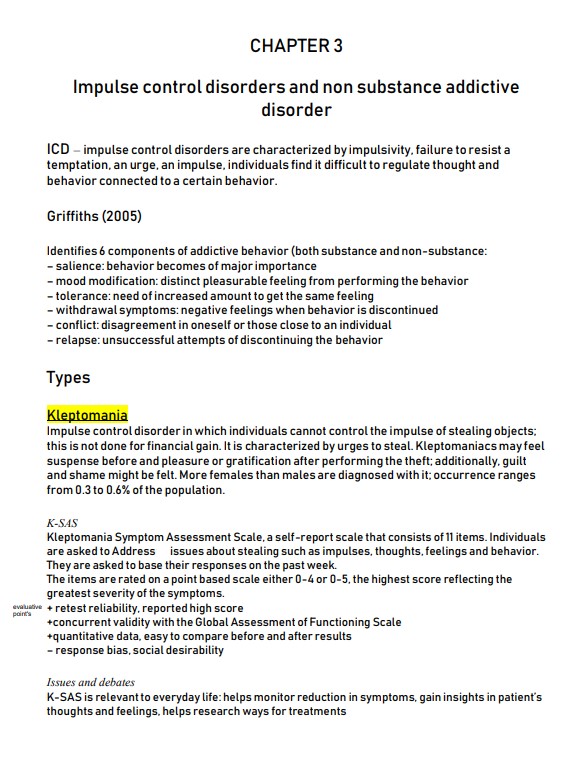Impulse Control and NonSubstance Addictive Disorders
Summary:
This note about Impulse Control and NonSubstance Addictive Disorders discusses impulse control disorders (ICD) and non-substance addictive disorders, including kleptomania, pyromania, and gambling disorder. It covers various explanations for these disorders, such as biochemical, behavioural, and cognitive, and treatments such as opiates, covert sensitization, imaginal desensitization, and impulse control therapy. The chapter also includes a discussion of the Kleptomania Symptom Assessment Scale (K-SAS) for assessing kleptomania symptoms.
Excerpt:
Impulse Control and NonSubstance Addictive Disorders
Definition
ICD – impulse control disorders are characterized by impulsivity, failure to resist a
temptation, an urge, an impulse, individuals find it difficult to regulate thought and
behaviour connected to a certain behaviour.
Griffiths (2005)
Identifies 6 components of addictive behaviour (both substance and non-substance:
– salience: behaviour becomes of major importance
– mood modification: distinct pleasurable feeling from performing the behaviour
– tolerance: need of increased amount to get the same feeling
– withdrawal symptoms: negative feelings when behaviour is discontinued
– conflict: disagreement in oneself or those close to an individual
– relapse: unsuccessful attempts to discontinue the behaviour
Types
Kleptomania
Impulse control disorder in which individuals cannot control the impulse to steal objects;
this is not done for financial gain. It is characterized by urges to steal. Kleptomaniacs may feel
suspense before and pleasure or gratification after performing the theft; additionally, guilt
and shame might be felt. More females than males are diagnosed with it; occurrence ranges
from 0.3 to 0.6% of the population.
K-SAS
Refers to the Kleptomania Symptom Assessment Scale, a self-report scale that consists of 11 items. Individuals
are asked to Addresses issues about stealing, such as impulses, thoughts, feelings, and behaviour.
They are asked to base their responses on the past week.
The items are rated on a point-based scale, either 0-4 or 0-5, the highest score reflecting the
greatest severity of the symptoms.
+ retest reliability, reported high score
+concurrent validity with the Global Assessment of Functioning Scale
+quantitative data, easy to compare before and after results
– response bias, social desirability


Reviews